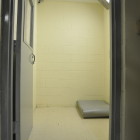
N.J. Solitary Confinement: Extreme Cases of Life ‘In the Box’
|
A recent lawsuit and its settlement have placed New Jersey's use of punitive solitary confinement of juveniles in the spotlight of a national debate over the practice.
Juvenile Justice Information Exchange (https://jjie.org/page/285/)

In late September, Torri was driving down the highway with her 11-year-old son Junior in the back seat when her phone started ringing.
It was the Hamilton County Sheriff’s deputy who worked at Junior’s middle school in Chattanooga, Tennessee. Deputy Arthur Richardson asked Torri where she was. She told him she was on the way to a family birthday dinner at LongHorn Steakhouse.
“He said, ‘Is Junior with you?’” Torri recalled.
Earlier that day, Junior had been accused by other students of making a threat against the school. When Torri had come to pick him up, she’d spoken with Richardson and with administrators, who’d told her he was allowed to return to class the next day. The principal had said she would carry out an investigation then. ProPublica and WPLN are using a nickname for Junior and not including Torri’s last name at the family’s request, to prevent him from being identifiable.
When Richardson called her in the car, Torri immediately felt uneasy. He didn’t say much before hanging up, and she thought about turning around to go home. But she kept driving. When they walked into the restaurant, Torri watched as Junior happily greeted his family.
Soon her phone rang again. It was the deputy. He said he was outside in the strip mall’s parking lot and needed to talk to Junior. Torri called Junior’s stepdad, Kevin Boyer, for extra support, putting him on speaker as she went outside to talk to Richardson. She left Junior with the family, wanting to protect her son for as long as she could ...

A recent lawsuit and its settlement have placed New Jersey's use of punitive solitary confinement of juveniles in the spotlight of a national debate over the practice.

UPDATE: March 11, 2014
The Southwest Idaho Juvenile Detention Center (SIJDC) in Caldwell, Idaho became the first detention facility of any sort to be certified as compliant with the standards of the 2003 Prison Rape Elimination Act (PREA). The facility houses 90 youth. PREA was enacted by Congress to “provide for the analysis of the incidence and effects of prison rape in Federal, State, and local institutions and to provide information, resources, recommendations and funding to protect individuals from prison rape.”
The Bureau of Justice Statistics and the National Institute for Justice were mandated to conduct research on the issue and the Bureau of Justice Assistance along with the National Institute of Corrections were tasked with supporting efforts in the state, juvenile, community and jail systems.
The latest data from the Annie E. Casey Foundation shows 70,792 juveniles in detention as of 2010. According to the National Institute for Justice there is no consensus among researchers about the incidence of sexual assault in U.S. facilities. The most recent BJS report, from 2012, indicated that nearly 10 percent of adjudicated juveniles reported being a victim to sexual assault.
The National Prison Rape Elimination Commission was charged with creating standards to implement the law.

It is a fact that it is not easy being black or Latino in the United States. More specifically, it’s not safe, particularly for boys and young men. As a nation we seem reluctant to fully confront this reality, or to address its causes and long history. In some quarters there is also an obstinate unwillingness to acknowledge anything beyond personal responsibility or to extend assistance to people based on social and historical realities. In this world view those having a tough time — the poor, minorities, the unemployed, drug users, juvenile delinquents and others — have only themselves to blame for their situation.

The state of Washington is one of eight that allows open access to juvenile arrest records. What this means is anybody interested in performing a thorough background check — including landlords, employers, reporters, private investigators or, some worry, less savory people, such as pimps or abusive partners — can walk down to the courthouse and see whether someone ran afoul of the law as a kid.
Meanwhile, Washington’s Administrative Office of the Courts, which oversees the state’s court system, disseminates data files that include juvenile records. These, in turn, are sold to private consumer reporting companies.
But, the Washington state Legislature is considering a bill to change all of that.

At 17, Michael Kemp spent six months in solitary confinement.

Attempts at reducing disproportionate minority contact (DMC) and disparate treatment of racial and ethnic youth in the justice systems of our country have not made much progress. Advocates, foundations, courts and stakeholders have exercised words and approaches, but the numbers don’t lie. According to the Juvenile Justice Information Exchange’s recent analysis of federal data from 1990 and 2010, minority youth were greatly over-represented at every point of the system. The comparison of that 20-year span shows little to no improvement of DMC in arrests, adjudications, detentions and transfers to adult court. Perhaps part of the problem is that we continue focusing on effects instead of causes.

We need to do a much better job ensuring that teens who are lesbian, gay, bisexual, transgender or questioning (LGBTQ) are treated equitably by the juvenile justice system. A report from the Equity Project, tells us that LGBTQ youth are more likely than their heterosexual peers to be placed in a juvenile detention facility. Additionally, Dr. Angela Irvine has found that LGBTQ youth are detained at nearly double the rate of heterosexual teens for status offenses, like skipping school and running away from home. Status offenses are behaviors that constitute a crime merely because the person who engaged in them is not an adult.
Advocates believe this disparity in detention rates is due in part to implicit bias among some police and judicial officers who may feel that these teens would not be safe in the community. Once behind bars, however, they are often anything but safe.

Alhough gay and transgender youth make up just 5 to 7 percent of the overall national population, LGBTQ youth represent up to 15 percent of the total juvenile justice population, according to a report by the Center for American Progress. And that may be a conservative estimate, experts say.